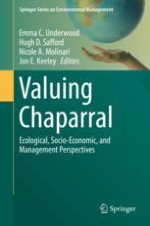2018 | OriginalPaper | Buchkapitel
14. Climate Change Trends for Chaparral
verfasst von : Nicole A. Molinari, Emma C. Underwood, John B. Kim, Hugh D. Safford
Erschienen in: Valuing Chaparral
Aktivieren Sie unsere intelligente Suche, um passende Fachinhalte oder Patente zu finden.
Wählen Sie Textabschnitte aus um mit Künstlicher Intelligenz passenden Patente zu finden. powered by
Markieren Sie Textabschnitte, um KI-gestützt weitere passende Inhalte zu finden. powered by
